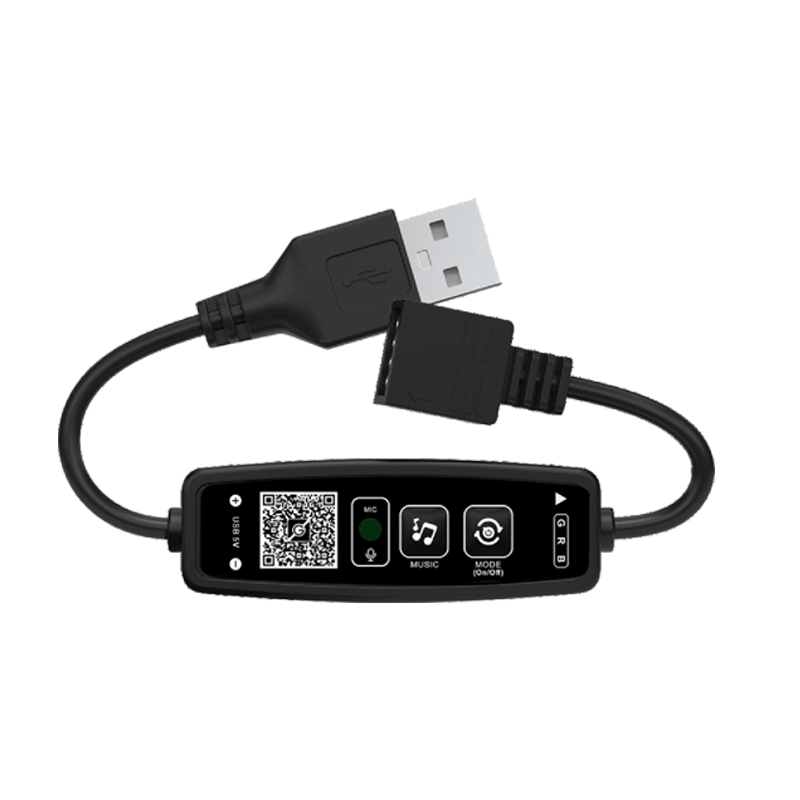A Bluetooth LED controller is a device that uses Bluetooth technology to wirelessly control LED lights. These Bluetooth LED controllers are often small and portable and can be used with a variety of smartphones, tablets, and other devices.
They typically allow users to adjust the color and brightness of their LED lights and can be used to create dynamic lighting effects. Some Bluetooth LED controllers may also have additional features, such as the ability to create and save lighting scenes, or to control multiple sets of LED lights at once.
These controllers are a convenient and versatile option for controlling LED lighting in a wide range of applications.

Table of Contents
ToggleWhen choosing a Bluetooth LED controller?
There are a few key factors to consider:
1. Compatibility: Make sure the Bluetooth led light controller is compatible with your LED lights and smartphone. Most controllers will specify the type of LED lights they are compatible with, and whether they are compatible with iOS or Android devices.
2. Range: Consider the range of the Bluetooth LED light controller. This will determine how far away from the lights you can be and still be able to control them. A longer range can be useful if you want to be able to control your lights from different rooms in your house.
3. Features: Look for a Bluetooth LED light controller with features that meet your needs. For example, if you want to be able to create custom lighting scenes, look for a controller that offers this capability.
4. Price: Consider your budget when choosing a Bluetooth LED controller. There is a wide range of options available at different price points.
5. Reviews: Before making a purchase, it can be helpful to read reviews from other customers to get a sense of the quality and performance of the Bluetooth LED light controller. This can help you make an informed decision.
What’s the feature of the Bluetooth LED controller
Bluetooth LED controllers vary in terms of the features they offer, but some common features include the ability to control the color and brightness of the lights, create custom lighting scenes, and set schedules for the lights to turn on and off automatically.
Some LED controllers may also offer additional features such as the ability to control multiple sets of lights or integration with voice assistants such as Amazon Alexa or Google Assistant. It’s important to consider the features you need and look for a controller that offers them.
How to connect the Bluetooth LED controller?
To connect a Bluetooth LED controller, follow these steps:
Install the light controller according to the manufacturer’s instructions.
This typically involves plugging the controller into a power source and connecting it to your LED lights.
Install the App for the LED controller on your smartphone.
This App will be used to control the lights and access the controller’s features.
Turn on the Bluetooth feature on your smartphone and make sure it is within range of the LED controller.
Open the app and follow the on-screen instructions to connect to the 12V LED light controller.
This may involve selecting the LED controller from a list of nearby devices or entering a code provided by the controller.
Once connected, you can use the App to control the lights and access the LED controller’s features.
Note: The exact steps for connecting a Bluetooth LED controller may vary depending on the specific controller you are using. Consult the manufacturer’s instructions for more detailed information.
How to Fix Your led controller
If your Bluetooth LED controller is not working properly, there are a few troubleshooting steps you can try to fix the problem:
1. Check the connections: Make sure the light controller is securely connected to both the power source and your LED lights.
2. Restart the Bluetooth LED controller: Try unplugging the light controller from the power source and then plugging it back in. This can sometimes reset the LED strip Bluetooth controller and fix any problems.
3. Update the App: If you are using a smartphone App to control the lights, make sure you have the latest version of the app installed. Outdated Apps can sometimes cause problems.
4. Check the range: If the Bluetooth LED controller is not responding to your commands, make sure your smartphone is within range of the LED controller. The range of the controller may be limited, and you may need to be closer to it to control the lights.
5. Reset the controller: If the above steps do not fix the problem, try resetting the light controller. This may involve pressing a reset button on the controller or following a specific reset process as outlined in the manufacturer’s instructions.
If these troubleshooting steps do not fix the problem, you may need to contact the manufacturer for further assistance.
How does Bluetooth LED controller work?
A Bluetooth LED controller works by using a Bluetooth connection to communicate with a smartphone or other compatible device.
The controller is typically connected to a power source and to an LED light strip or other LED lighting system. The user can then use a dedicated app on their smartphone to control the lights and access the controller’s features.
The App allows the user to adjust the color and brightness of the lights, create custom lighting scenes, and set schedules for the lights to turn on and off automatically.
The App sends commands to the controller over the Bluetooth connection, which then adjusts the lights accordingly. The controller may also have buttons or other controls that allow the user to adjust the lights directly without using the App.
Overall, a Bluetooth LED controller provides a convenient way to control LED lights using a smartphone, allowing the user to create custom lighting effects and easily adjust the lights to suit their needs.
When does a Bluetooth LED controller become necessary?
A Bluetooth LED controller may be necessary if you want to have more control over the color and brightness of your LED lights, or if you want to be able to create custom lighting scenes or schedules.
Without a LED controller, you would need to adjust the lights manually or use a separate device such as a remote control.
A Bluetooth LED controller allows you to easily control the lights using your smartphone, providing a convenient and versatile way to adjust your lighting.
Additionally, if you have a large number of LED lights, or if your lights are installed in hard-to-reach places, a Bluetooth LED controller can make it much easier to control them. Rather than having to adjust each light individually, you can use the controller to adjust all of the lights at once. This can save time and effort, and make it more convenient to use your LED lights.
Overall, a Bluetooth LED controller can be a useful addition to any LED lighting setup, providing greater control and convenience for the user.
Advantages and Disadvantages of Bluetooth LED Controller
Bluetooth LED controllers have several advantages over other types of controllers.
One major advantage is that they are wireless, so they are easy to install and can be used in a wide range of applications.
Additionally, Bluetooth technology is widely available and compatible with many different devices, so Bluetooth LED controllers can be used with a variety of smartphones, tablets, and other devices. This makes them a versatile and convenient option for controlling LED lighting.
Another advantage of Bluetooth LED controllers is that they can be controlled remotely, allowing users to change the color and brightness of their LED lights from a distance.
This can be useful for creating dynamic lighting effects and can make it easier to control lighting in large or hard-to-reach areas.
However, there are also some disadvantages to using Bluetooth LED controllers. One of the main drawbacks is that Bluetooth has a relatively short range, so the controller may not be able to reach all of the LED lights in a large space.
Additionally, Bluetooth technology can be affected by interference from other devices, which can cause connectivity issues.
Overall, the advantages and disadvantages of Bluetooth LED controllers will depend on the specific application and the requirements of the user. While they offer many benefits, they may not be the best choice for every situation.
Conclusion
In conclusion, Bluetooth LED controllers are a convenient and versatile option for controlling LED lighting. They are wireless, easy to install, and can be used with a wide range of devices.
Additionally, they allow users to control their LED lights remotely, which can be useful for creating dynamic lighting effects and for controlling lighting in large or hard-to-reach areas. However, Bluetooth technology has a relatively short range and can be affected by interference, so Bluetooth LED controllers may not be the best choice for every situation.
Overall, the advantages and disadvantages of these Bluetooth LED controllers will depend on the specific application and the requirements of the user.
